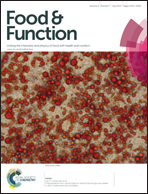Effects of the olive oil phenol metabolite 3,4-DHPEA-EDAH2 on human erythrocyte oxidative damage
Abstract
Red blood cells (RBCs), as anucleated cells, have poor repair and biosynthetic mechanisms, suffering and accumulating oxidative lesions whenever oxidative stress develops. RBCs are particularly exposed to endogenous oxidative damage because of their specific role as oxygen carriers. However, as the most abundant blood cells, RBCs also play an important role in the oxidative status of the whole blood constituents. In previous studies by our group, the most important polyphenolic compounds found in virgin olive oil, 3,4-dihydroxyphenylethanol-elenolic acid (3,4-DHPEA-EA) and 3,4-dihydroxyphenylethanol-elenolic acid dialdehyde (3,4-DHPEA-EDA), were shown to significantly protect RBCs from oxidative damage initiated by AAPH and H2O2, with the most active compound being 3,4-DHPEA-EDA. However, the in vivo protective effects of these phenols are dependent on their bioavailability. It has been demonstrated that 3,4-DHPEA-EDA is absorbed by intestinal cells and is then metabolized, yielding a reduced metabolite, 3,4-DHPEA-EDAH2. In order to assess the importance of VOO phenolic compound metabolites for the overall in vivo protective activity, the capacity of this phase I metabolite to protect RBCs in the presence of the radical initiators AAPH or H2O2 was evaluated in the presence and absence of the naturally occurring antioxidant, ascorbic acid. The metabolite was shown to protect RBCs from haemolysis induced by both initiators, in a dose dependent way, after 2 h and 4 h of incubation. The protective effect was however lower than that of the parental compound. The analysis of the membrane proteins of erythrocytes showed that the metabolite can interact with these biological structures.


 Please wait while we load your content...
Please wait while we load your content...